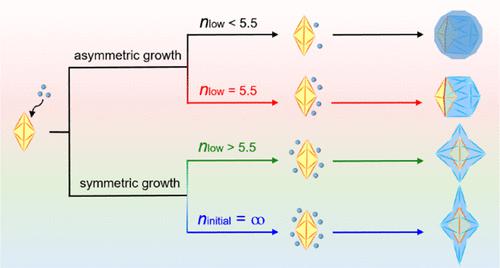当前位置:
X-MOL 学术
›
J. Am. Chem. Soc.
›
论文详情
Our official English website, www.x-mol.net, welcomes your feedback! (Note: you will need to create a separate account there.)
Twin Proliferation and Prolongation under Kinetic Control: Pd–Au Janus Icosahedra versus Pd@Au Core–Shell Starfishes
Journal of the American Chemical Society ( IF 15.0 ) Pub Date : 2023-06-09 , DOI: 10.1021/jacs.3c03682 Xiaoyu Qiu 1, 2 , Veronica Pawlik 3 , Shan Zhou 3 , Jing Tao 4 , Younan Xia 1
Journal of the American Chemical Society ( IF 15.0 ) Pub Date : 2023-06-09 , DOI: 10.1021/jacs.3c03682 Xiaoyu Qiu 1, 2 , Veronica Pawlik 3 , Shan Zhou 3 , Jing Tao 4 , Younan Xia 1
Affiliation

|
Heterogeneous bimetallic nanocrystals featuring explicit spatial configurations and abundant twin defects can simultaneously enable geometric and ligand effects to enhance catalytic and photonic applications. Herein, we report two growth patterns of Au atoms on penta-twinned Pd decahedra, involving twin proliferation to generate asymmetric Pd–Au Janus icosahedra and twin elongation to produce anisotropic Pd@Au core–shell starfishes, respectively. Mechanistic analysis indicates that the injection rate determines the lower-limit number (nlow) of Au(III) ions in the steady state and thus controls the growth pattern. When nlow ≤ 5.5, the kinetic rate is slow enough to initiate asymmetrical one-side growth but fast enough to outpace surface diffusion; Au tetrahedral subunits are successively proliferated along the axial ⟨110⟩ direction of Pd decahedra to form Pd–Au Janus icosahedra. Composed of five Pd and 15 Au tetrahedral subunits, such a heterogeneous icosahedron supports high (2.2 GPa) tensile strain and high strain difference up to +21.9%. In contrast, when nlow > 5.5, the fast reduction kinetics promotes symmetric growth with inadequate surface diffusion. As such, Au atoms are laterally deposited along five high-indexed ⟨211⟩ ridges of Pd decahedra to generate concave Pd@Au core–shell starfishes with tunable sizes (28–40 nm), twin elongation ratios (33.82–162.08%), and lattice expansion ratios (8.82–20.10%).
中文翻译:

动力学控制下的双胞胎增殖和延长:Pd-Au Janus 二十面体与 Pd@Au 核壳海星
异质双金属纳米晶体具有明确的空间构型和丰富的孪生缺陷,可以同时实现几何效应和配体效应,从而增强催化和光子应用。在此,我们报告了金原子在五孪生 Pd 十面体上的两种生长模式,分别涉及孪生增殖产生不对称的 Pd-Au Janus 二十面体和孪生伸长产生各向异性 Pd@Au 核壳海星。机理分析表明,注入速率决定了稳态下Au(III)离子的下限数量( n low ),从而控制了生长模式。当n低时≤ 5.5,动力学速率足够慢以引发不对称的一侧生长,但足够快以超过表面扩散;Au四面体亚基沿着Pd十面体的轴向⟨110⟩方向依次增殖,形成Pd-Au Janus二十面体。这种异质二十面体由 5 个 Pd 和 15 Au 四面体亚基组成,支持高 (2.2 GPa) 拉伸应变和高达 +21.9% 的高应变差。相反,当n low > 5.5 时,快速还原动力学会促进对称生长,且表面扩散不充分。因此,Au原子沿着Pd十面体的五个高指数⟨211⟩脊横向沉积,生成凹形Pd@Au核壳海星,其尺寸可调(28-40 nm),双伸长率(33.82-162.08%),和晶格膨胀率(8.82–20.10%)。
更新日期:2023-06-09
中文翻译:

动力学控制下的双胞胎增殖和延长:Pd-Au Janus 二十面体与 Pd@Au 核壳海星
异质双金属纳米晶体具有明确的空间构型和丰富的孪生缺陷,可以同时实现几何效应和配体效应,从而增强催化和光子应用。在此,我们报告了金原子在五孪生 Pd 十面体上的两种生长模式,分别涉及孪生增殖产生不对称的 Pd-Au Janus 二十面体和孪生伸长产生各向异性 Pd@Au 核壳海星。机理分析表明,注入速率决定了稳态下Au(III)离子的下限数量( n low ),从而控制了生长模式。当n低时≤ 5.5,动力学速率足够慢以引发不对称的一侧生长,但足够快以超过表面扩散;Au四面体亚基沿着Pd十面体的轴向⟨110⟩方向依次增殖,形成Pd-Au Janus二十面体。这种异质二十面体由 5 个 Pd 和 15 Au 四面体亚基组成,支持高 (2.2 GPa) 拉伸应变和高达 +21.9% 的高应变差。相反,当n low > 5.5 时,快速还原动力学会促进对称生长,且表面扩散不充分。因此,Au原子沿着Pd十面体的五个高指数⟨211⟩脊横向沉积,生成凹形Pd@Au核壳海星,其尺寸可调(28-40 nm),双伸长率(33.82-162.08%),和晶格膨胀率(8.82–20.10%)。


























 京公网安备 11010802027423号
京公网安备 11010802027423号